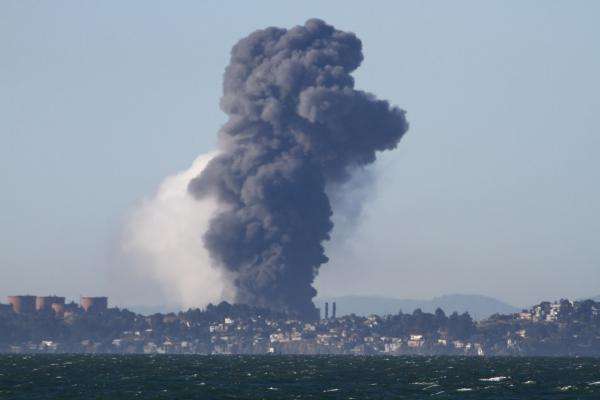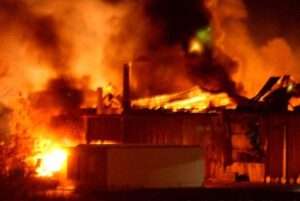
West Virginia State University, a 125-year-old historically black university, rested for decades on the fence line of a pesticide manufacturer, a stone’s throw from tanks holding lethal amounts of one of the world’s most dangerous and infamous chemicals, methyl isocyanate.
The chemical, known as MIC, was responsible for the deaths of thousands of residents in Bhopal, India, in 1984 and was a process chemical for the Bayer CropScience pesticide plant in Institute, W.Va., on the Kanawha River nine miles west of Charleston.
For years, Bayer had ignored pressure from nearby residents and the university to eliminate use of the compound. That evasion began to ebb in 2008, when the West Virginia plant blew up, killing two workers and forcing 40,000 residents and students to scramble into indoor shelters to dodge the smoke and particles that swept through the community.
The university’s 3,500 students are not alone in living next to a dangerous neighbor. More than 11 million people of color reside on the fence line of large, high-risk U.S. chemical plants and oil refineries that handle large amounts of hazardous chemicals. They make up half of Americans who live next to a potentially dangerous chemical factory.
Children of color are almost two-thirds of the 5.7 million U.S. kids who live within one mile of a high-risk chemical facility. About 12,000 schools can be found within one mile of these plants; one in 10 U.S. children attends these schools and more than one-quarter of these students are under the age of five, making them particularly susceptible to toxic chemical releases.
The U.S. Environmental Protection Agency has identified more than 12,500 plants as high risk and potentially dangerous because of the quantity of toxic and flammable chemicals they handle.
This EPA-collected information was analyzed by several community groups in recent years and merged with demographic data. The data is now housed in a repository maintained by the Houston Chronicle.
Although the federal agency calls for the companies to report this information, EPA does not require companies to limit or eliminate the chemicals or to take added precautions to protect the communities, schools and residents on the fence line. And accidents do happen.
The Chemical Safety Board, an independent federal agency that investigates chemical plant accidents, estimates some 250 significant industrial accidents occur each year. Many of those affected are communities of color, and those facilities have nearly twice the accident rate of chemical plants and refineries in white neighborhoods.
Two cities—Richmond, Calif., and Institute—are textbook examples of how poor plant decisions are made and how they affect communities of color. But these cities’ stories also suggest a path to make positive change—a tragic accident occurs, an independent investigation shows what went wrong, and pressure from community groups and others lead to improved safety.
At Bayer, a runaway chemical reaction set off a fire and explosion during the restart of the plant’s pesticide manufacturing process. Two workers were sent to investigate in the moments before the fire, both died. The fire burned for more than four hours, shutting down an interstate freeway and causing resident to flee despite the shelter-in-place warnings. The company first blocked the Chemical Safety Board from investigating the accident, citing vague terrorism fears, and then denied toxic chemicals had escaped into the community. However, the claim was found to be baseless as the only fence line air monitors that could have detected air pollution were not working.
Community tension built, and although the tanks holding tons of MIC were not affected, flying debris blasted through the plant and landed near where MIC was used and stored.
CSB’s accident investigation found Bayer had failed to adequately train workers and had ignored safe manufacturing practices in a rush to restart the plant. The investigation also found that the pesticide plant was the only facility in the U.S. and likely in the world that stored MIC. The Institute plant was a sister to the Union Carbide plant in Bhopal.
Following more revelations about the accident, congressional hearings and a drumbeat of community opposition, in 2012, four years after the accident, Bayer dropped products requiring MIC.
Today, Dow Chemical owns the plant and manufactures a mix of chemical products that don’t use MIC. However, the industrial park that housed Bayer and six other chemical companies remains active, as does West Virginia State University.
Over the years, Pam Nixon has watched the Institute industrial park and the community near it grow. She is a long-time resident, an African American and a leader in the local organization People Concerned About MIC. With MIC’s elimination, Nixon still monitors the plants as a leader in People Concerned About Chemical Safety.
The university, she notes, goes back a century. The West Virginia Colored Institute was founded in 1891 as one of 19 land-grant institutions authorized by Congress and designated by the states to provide for the education of black citizens. An air field eventually adjoined the university and during World War II, a government supported synthetic rubber manufacturer began war-effort operations. In 1947, Union Carbide bought the land from the government and established chemical manufacturing facilities. Today the industrial park is home to several chemical manufacturers, a large asphalt plant, and rail lines, as well as university housing, a daycare center, homes and the university.
“It is better now,” Nixon says. “The air is cleaner and the plants are a little less polluting. Many of the old facilities have been torn down, but there is a new company coming in that gives us consternation.”
U.S. Methanol Company has broken ground for a new large methanol plant at the Institute site. It will be reconstructed from parts of a similar plant shut down in Brazil. Methanol is a feedstock production chemical, made from natural gas. Thanks to the U.S. shale gas revolution, it is cheap and readily available.
U.S. Methanol has announced it will hire local plant operators formerly employed by Bayer and that concerns Nixon.
“We worry it will be like the old Bayer plant,” Nixon says. “There was a history of accidents at the Bayer plant, and we have seen that the safety culture of Bayer led to the fires, explosions and shelter-in-place warnings. We worry there will be more accidents.”
But Nixon remains vigilant. “The industrial park is not going away and neither are we.”
Across the country, at Richmond, California, a huge fire at a Chevron refinery in the predominately black and Hispanic north San Francisco Bay Area community in 2012 sent 15,000 frightened residents to area hospitals seeking treatment for smoke inhalation and breathing difficulties. Nineteen workers were engulfed in hydrocarbons vapors but luckily escaped before the vapors turned into a fireball. The cause was the rupture of a badly corroded process pipe. The result was fire and the release of black smoke, particulates and hydrocarbons, blasting hundreds of feet above the plant and into the surrounding community.
The Chemical Safety Board accident investigation found that for a decade Chevron managers had heard at least six times from their own engineers that pipes in the plant’s massive crude oil processing unit were corroding and needed replacement. Managers ignored those warnings, even after a corroded pipe failed in 2007, causing a fire that injured one worker and called for a shelter-in-place warning. In 2009, Chevron engineers warned of a possible “catastrophic failure” of the plant but still managers deferred action.
Even before the 2012 accident, Chevron’s history had created a difficult relationship with residents, according to several long-time residents living on Chevron’s fence line. The accident was hard to ignore, visually and politically. The fire’s plume could be seen throughout the Bay Area. The accident sent thousands to seek medical aid and it occurred in a well-organized community with a history of distrust and anger towards the refinery. The CSB investigation brought about a public discussion of its findings, which were highly critical of the company and recommended a sweeping regulatory change for California refineries.
The conditions that placed residents on the company fence line are long-time racist housing patterns, says Henry Clark, a 75-year resident and African American, who is a leader of Richmond’s West County Toxics Coalition and several national environmental justice organizations.
“Next to the refinery was the only place people of color could live in the early days because of racist real estate practices,” he says. “They couldn’t get a home anywhere else. That is how we got on the front lines of the chemical industry. This isn’t unique to Richmond. These are the same patterns you see across the nation.”
Clark says Chevron has embarked on a modernization program and claims to become more in touch with the community. “Today may be better than in the past,” he says. “But tomorrow could be a different story, and if so, I will be back at the refinery’s gates.”
Following the accident investigation, California Gov. Jerry Brown launched an interagency refinery working group to examine refinery regulations. After nearly five years of meetings with companies, workers, community members, and state, federal and local agencies, the group developed a new regulatory system, notes Mike Wilson.
Wilson led the effort as the state labor agency’s chief scientist. He says the new regulation is a national model and believes it will transform refinery safety.
Among the most sweeping changes, Wilson says, are provisions requiring companies to sit down with workers and discuss process changes and improvements. Because the discussions are now public, they will result in transparency for community members and accountability for management.
The new deal calls for refineries to embrace inherently safer production processes, provisions long-sought by communities but distressing to companies. Such provisions require company engineers and managers to first consider substituting less toxic chemicals and simpler production processes, rather than adding complex systems to control potential runaway reactions. They must document their search for safer methods.
“The process management discussions will have direct impact on the community,” he says. “In the past, these production decisions were made solely by management and behind closed doors.”
“Consequently in California with the new requirements, MIC could never be stored at Bayer and the corroded pipe at Chevron would have been replaced,” Wilson says.
The state is now implementing the new regulation, Wilson says, adding that Washington state is also considering California’s approach. Like California, Washington has had several deadly refinery accidents.
How the new regulations play out could light a path for the rest of the country.
Workers and community members share a primary interest in safety, he notes, applauding the community groups on the fence line that have kept pressing for safety. The results bode well at least for now. Unfortunately, a deadly and injurious accident was needed to bring them about.
Jeff Johnson, a Washington, D.C. science and technology writer, researched industrial accidents under a fellowship from the Alicia Patterson Journalism Foundation.
© 2017 Jeff Johnson



